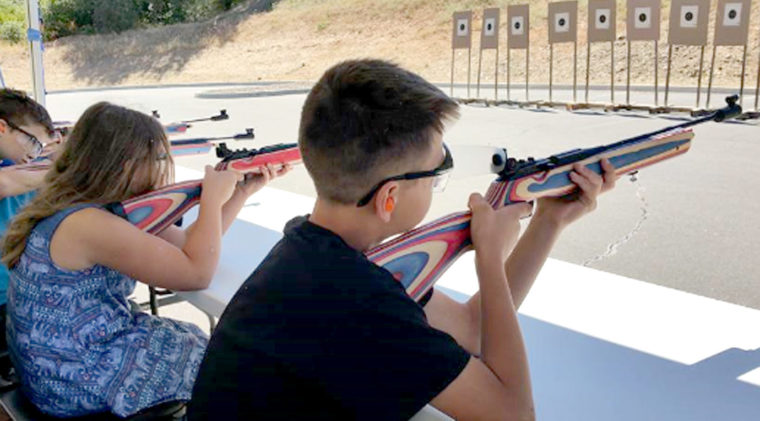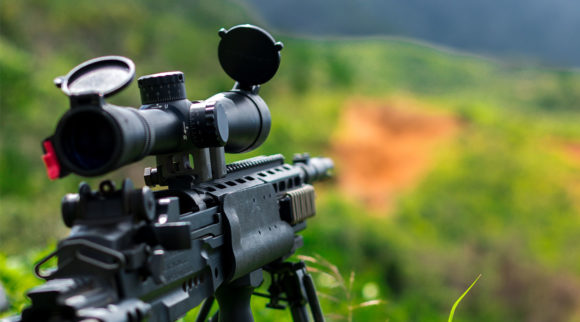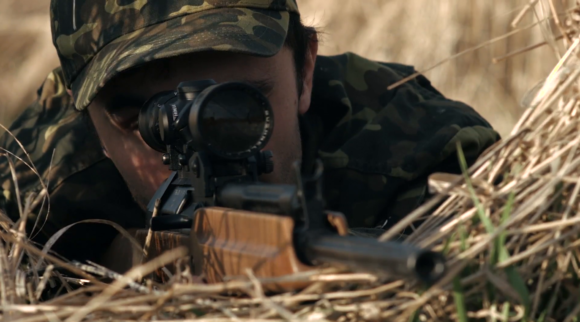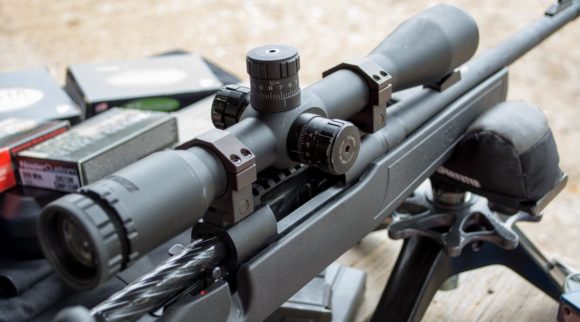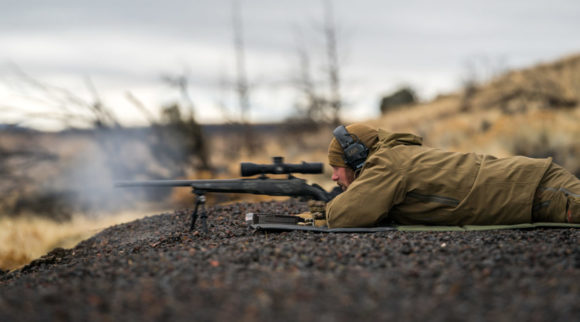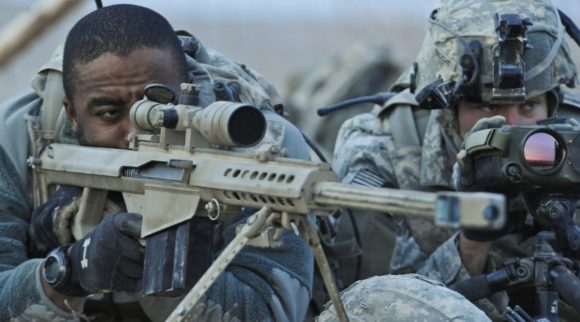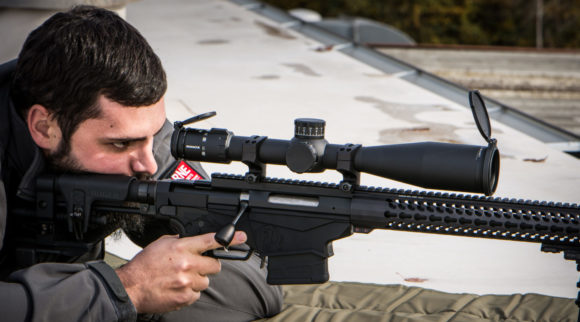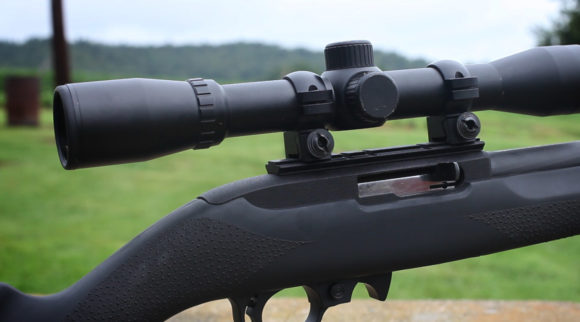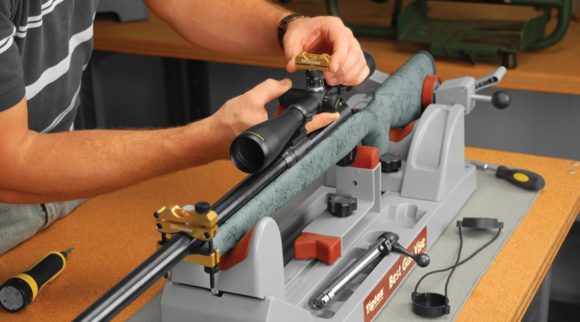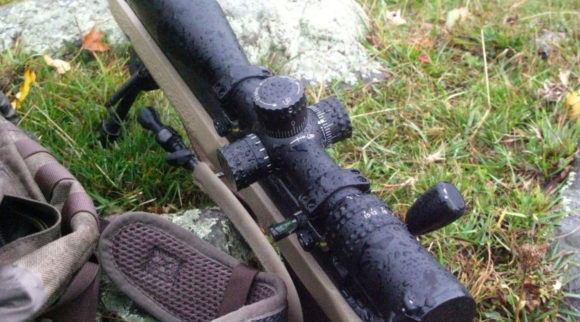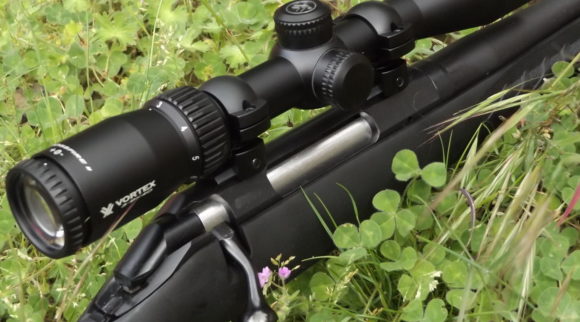What Is Eye Relief? Understanding A Critical Component Prior To Selecting A Scope

What is eye relief, and why is it so important to select the best scope? You’re about to learn all that and more—like how an eye relief scope can help up your shooting game. After all, nothing is better than getting out to the range to zero a new scope.
You have picked the best day of weather, you have planned, packed, and loaded all of your gear in to your vehicle. You may have painstakingly hand-loaded rounds to gain maximum performance from your rifle and scope combo. Your target is set up and you begin the slowly squeeze the trigger. As the bullet leaps from end of your rifle you feel something punch you right in the eye. You reach your hand up to feel your face and you can see blood on your fingers. At this point, you realize you have just been “scoped” or “scope bit” and you will have “scope eye” for a few days. You planned everything meticulously, how could this have happened? This happens to many shooters because of something called “eye relief”. So, what is it?
Eye relief is a bit of a misnomer. It has nothing to do with giving your eye a break from looking through an optic of any type. In this article we will discuss eye relief for rifle scopes, but eye relief is important for other optics. Binoculars and spotting scopes all have a set eye relief. Generally, if you underestimate the eye relief of binoculars, they will not leave you with a black eye.
See Top Article: Best Rifle Scope
Let’s keep the definition of eye relief simple. Eye relief is the exact distance from the eyepiece where the user can see the complete picture of what is being magnified. If your eye is too close to the eyepiece, the object will be fuzzy and out of focus. If your eye is too far from the eyepiece, the object will appear as a small dot in the center of the lens. Eye relief may be the single most important factor when a shooter needs to buy a new scope.
When you purchase any type of optical device (a rangefinder, spotting scope, etc.) there are a large amount of statistics written on the box. Those statistics display the optimum conditions needed for the device to work as manufactured. When it comes to rifle scopes, knowing what eye relief is can be important for several reasons. The first reason, eye relief can protect the shooter from the recoil of heavy caliber rounds. The second reason, the shooter needs to maintain a good cheek weld on their buttstock to be accurate shot after shot. If the shooter has to keep their cheek off their buttstock to maintain a clear image through their rifle scope, their shots may not be accurate. Inaccurate shots can lead to unethical hits on big game or misses during a competition.
What is Eye Relief & Why Does it Matter?
 It is easy to determine why eye relief is important. The best way to do this is to grab a scope and hold it at arms-length from your face. At that distance, nothing but a small dot can be seen. As you move it towards your face it becomes clearer until it reaches a point where the object is large and clear. This is the proper eye relief for this scope. Now that you have determined how far the scope needs to be from your eye, you are done, right? Wrong.
It is easy to determine why eye relief is important. The best way to do this is to grab a scope and hold it at arms-length from your face. At that distance, nothing but a small dot can be seen. As you move it towards your face it becomes clearer until it reaches a point where the object is large and clear. This is the proper eye relief for this scope. Now that you have determined how far the scope needs to be from your eye, you are done, right? Wrong.
There are several factors that affect how eye relief will affect the shooter. First off, a scope only has so much space for rings. A rifle only has only so much space to mount those rings. If a scope does not line up properly on a shooter’s rifle, why would the shooter want that scope? It does not matter how much eye relief a scope has if the position of the scope affects how the shooter shoots their rifle. As mentioned earlier, adjusting yourself to a scope that is too high, too far forward or backward, could have unsatisfactory results.
Another factor a shooter needs to consider when determining if eye relief matters is bullet caliber. When shooting a light recoiling .22 LR, a shooter could get away with relief of 2 inches or less. If a shooter is firing the heavy recoiling 300 Remington Ultra Magnum, they need eye relief of 3.5 to 4 plus inches. The longer eye relief will definitely protect the shooter from receiving an unwanted cut or bruise. A third factor to consider when looking at eye relief distances is field of view.
Field of view is another one of those stats listed on the outside of an optics box that some people may never notice. To explain, in an ideal world your scope would have a field of view of 100 yards (the length of a football field) at 100 yards. Then, if a target was standing on the 50-yard line, and you placed it in the center of the scope, you would see both goal posts on the sides of the image. In reality, this number is actually closer to 40 feet on the low end, shrinking down to 20 feet or less when you increase the magnification. Because of the laws of optical physics, when you increase the eye-relief distance, you shorten the field of view. Under 100 yards, a field of view of 40 feet is more than enough. This will allow the shooter to quickly locate their target and make a good shot. Even though the field of view shrinks at longer ranges, a shooter will generally have more time to acquire their target so a small field of view is not a hindrance to them.
Related: Best Scope Under $500
The last thing to consider is how eye relief is affected by glasses. When a scope has shorter eye relief, people wearing glasses will have increased problems with vignetting. This is caused by the inability of the shooter to get close enough to the scope. This is more of a problem with rangefinders and spotting scopes, but can also be a problem if the shooter needs a scope with short eye relief for whatever reason.
How is Eye Relief Measured?
This is the point of the article where science will be used to describe eye relief and how it is measured.
All scopes and sporting optics work by magnifying light through the use of a lens or a series of lenses. Incoming light is channeled and refracted into a cone of light. The cone of light rays that pass through the eye piece is officially known as the exit pupil. Most of the time, the term exit pupil is used in photography. It is also applicable when it comes to scopes and binoculars. Effectively, the measurement of the exit pupil is usually described in either inches or millimeters, referring to the diameter of the cone of light that could can reach the eye of the user of the instrument.
The way modern scopes and binoculars are constructed, the exit pupil diameter is often deliberately designed to be larger than the user’s pupil. This means that there is more of an image being channeled through the lenses than the eye can comfortably take in with one glance. This is a engineering strategy to allow for the user to move slightly to the side of the eye piece without losing any visual information, a term known in the business as vignetting or clipping. The eye relief is therefore the distance from the eyepiece that the entire image can be viewed in its entirety, and rarely matches the same measurements for the exit pupil.
Eye relief is calculated to determine the maximum amount of distance the eyes of the user can be from the scope when used at its most powerful magnification and still retail a full image as focused through the lens(es).
You may have read a term above know as vignetting. Vignetting is when you look through the eyepiece and there is a crescent moon shape on the bottom or sides of your field of view. If you notice this, you are too close to the eyepiece. If the vignetting appears around the entire field of view, your eye is too far from the eyepiece. Knowing exactly where to place your head every time you get behind your rifle will help reduce the need to adjust yourself to avoid vignetting. If you have a perfect field of view there will be no vignetting and your shots will land where you aimed them.
What is Scope Eye Relief: Types of Eye Relief
- Standard Eye Relief – the standard for most rifle scopes is 3.5 to 4.5 inches. This is more than enough when using rimfire and standard centerfire cartridges. Most shooters prefer to use standard eye relief scopes with the .308 Winchester and smaller. These scopes can still be used with magnum calibers, but a shooter needs to buy standard eye relief scope with eye relief on the upper limit of eye relief.
The standard eye relief scopes are great for rear mounting and can offer additional magnification and reticle options that long eye relief scopes cannot. They provide the highest levels of magnification and are ideal for those who want to take long range shots.
Standard eye relief scopes can make a rifle feel more balanced since you are not placing a lot of weight at the front of the gun. This will allow for a comfortable hold while firing. Depending on the total diameter of the lens you can have a fairly large scope rear mounted without throwing your weapon off balance.
Related: Best Scope Under $1000
There is not as much flexibility with a standard eye relief as there is with long eye relief. The field of view with standard eye relief scopes is generally smaller than with long eye relief scopes. This makes target acquisition at high magnifications difficult. In a nutshell, standard eye relief is great for shooting on flat terrain with mild recoiling calibers.
- Long eye relief – long eye relief scopes are considered any length longer than 4.5 inches. The extra inches are meant to protect the shooter from heavy recoiling calibers. Long eye relief scopes are a great asset when shooting any caliber uphill. As the shooter begins to aim up the hill, eye relief begins to get shorter and shorter.
Choosing long eye relief can have multiple advantages for a shooter. Long eye relief allows you to mount your scope further up on the rifle. Most of the time, mounting the scope forward of the action is known as the “scout mount”.
Scout mounting a scope allows you to have a wider field of view. Many riflemen with scout mounted scopes can shoot with both eyes open allowing them to quickly acquire their target. A wider field of view allows the shooter to transition between targets
The long eye relief scopes allow for a more natural shooting position for some shooters. Some find that the forward position of the scope gives them a more relaxed shooting position. Generally, a scout mounted optic sits lower on the rifle so that the shooter does not have to place their neck in an unnatural position to obtain a good sight picture. Being comfortable behind the scope can increase the length of time a shooter can scan terrain using their scope without getting muscle fatigue.
With bolt action rifles a long eye relief may be preferred for easy chambering. The scope can be mounted forward of the action on the rifle allowing you quick access. Having the ability to rapidly reload a bolt action can make all the difference when taking a second shot at a moving target. This applies to surplus rifles that have an open action. Surplus rifles weren’t usually made to have any type of scope mounted so the only viable space for a scope is forward of the action.
Long eye relief scopes have limited magnification. While they do have magnification, and provide additional clarity compared to iron sights, their magnification is small compared to short eye relief scopes. The average power for a standard eye relief scope will easily hit 8-10 and higher. In contrast, a long eye relief scope will usually not hit more than a power of 6 to 8. There is one downside to long eye relief scopes. The farther the shooter has their eye from the scope, the faster that light transmission dissipates. This makes hunting at dawn or dusk a bit more challenging.
Selecting the Best Scope
This portion of the article will not focus on which scope manufacturer is the best. This portion will focus on what type of eye relief you will need for a particular application.
- Handgun hunting. This is an often-overlooked form of hunting. Handguns and their accompanying scopes are meant to be held at arms-length. This means that handgun specific scopes have a very long eye relief. Their relief could actually be measured in feet instead of inches. Because of the overly long eye relief, handgun scopes are best used at 1x or 2x magnification. Anything higher than that and achieving a clear, full image of the target is nearly impossible without some type of shooting rest. Handgun hunting hasn’t been as popular as other forms of hunting, but with innovations in handgun caliber ammunition, it is making a comeback.
- Shotgun hunting. When most shooters thing about hunting with shotguns, they think of open sights aiming at a bird darting across the sky. They do not have time to acquire their target through a magnified scope. However, there are hunters that use scoped shotguns on other game than birds. Most shooters understand that a shotgun does have quite a bit of recoil. There are shotgun specific scopes that exist, but any scope that has 3.5 to 4.5 inches of eye relief should work on a shotgun. If the scope has enough eye relief to handle magnum calibers, it will work with shotgun shooting slugs.
- Rifle hunting – flat terrain. As mentioned earlier, shooting on flat terrain with medium caliber rounds, a shooter can use a scope that has standard eye relief. The scope can have eye relief that is shorter than needed for magnum calibers. As the shooter will not be aiming up slope or using magnum calibers to reach long distances, shorter eye relief will grant them enough magnification options to hunt any type of game.
- Rifle hunting – mountainous terrain. This is the type of hunting that a shooter will need to pick a scope with enough eye relief to work with magnum calibers shooting uphill. Hunting in mountainous regions requires lengthy shots that only magnum calibers are capable of ethically making. As the shooter may have to shoot up hill, the eye relief plays a major factor. If the eye relief starts out short for a standard shot, it will definitely be too short for a shot upslope. This could result in an injury to the shooter in terrain that is often unforgiving. The shooter needs to make sure that proper eye relief exits with their scope before heading out on a mountain hunt.
Observations and Conclusion
As you can see there are several factors that affect a shooter. Eye relief is probably the most overlooked aspect when it comes to purchasing a rifle scope. Most of the time a shooter will adjust to whatever scope they purchase because picking out the perfect rifle scope is time consuming.
The easiest way to demonstrate, to a hunter, why eye relief is important is using this scenario. Imagine you have drawn out a once-in-a-lifetime bull elk tag. Hours of hiking and carrying gear has led you to a point where you are across a canyon from that trophy elk. As you look through the scope, you cannot get comfortable behind the rifle because every time you look down the scope, there is some vignetting. Your neck muscles are beginning to become fatigued and you can no longer wait to fire the shot. You squeeze the trigger and the round misses. The elk begins moving as you chamber another round. Suddenly, you realize that your field of view through the scope is too narrow and you cannot track the bull. Your one chance on this hunt to bag a trophy elk was missed because you could not get proper eye relief on your scope.
If the time had been taken to pick the correct scope for the rifle caliber and shooter, that shot would have been easy. The shooter would just have to line up behind their rifle, maintain a consistent cheek weld, and line up a shot without vignetting or fatigue. With proper eye relief the field of view would be wide and a follow up shot, if needed, would be easy.
Shooters spend many hours and a lot money on customizing their rifle. Fluted barrels, trued actions, over-sized bolt knobs, and lightened triggers seem to the be the things that most shooters focus on. Most just feel that pulling a scope out of the box and placing it on their rifle with expensive rings will serve them just fine in the field. In order for a shooter to place accurate shots on target every time, the shooter must understand the important role that their scope plays. The scope may be clear, fully adjustable for parallax, and have the proper magnification, but all of that means nothing if it is not comfortable for the shooter to use.
Bottom line, before spending big bucks on a rifle scope, put your hands on it. Look through it and see where the perfect sight picture is for you. If it works with your rifle, buy it and be happy. If it does not work for you and your rifle, move on the to the next scope. Time spent now determining the best scope for you will save you from regrets when you miss that trophy during hunting season. Although eye relief seems like an insignificant stat on the outside of a scope box, it is an extremely important stat out in the field. Choose wisely and enjoy your hunt, your competition, or your plinking at the range.
